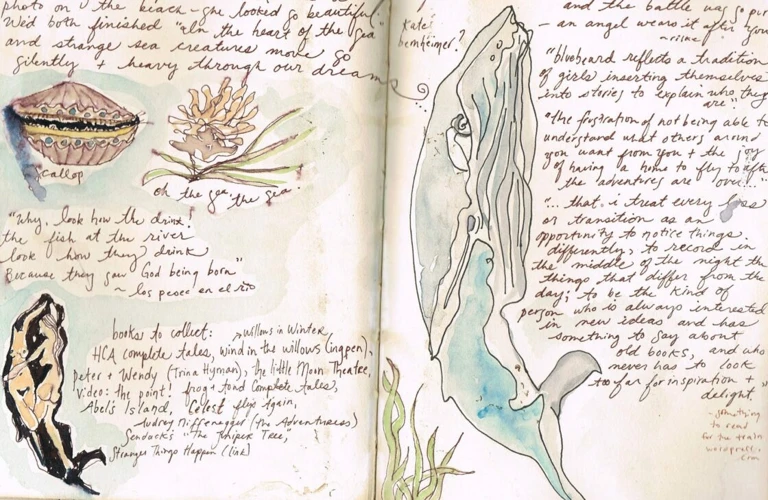Dreams have always been a source of mystery and fascination for people throughout history. From ancient civilizations to modern times, dreams have been perceived as a window to the soul, a divine manifestation, or even a vehicle for exploring the unconscious mind. Many famous individuals have kept dream journals, using them as a tool for self-reflection, creativity, and personal growth. In this article, we will delve into the dream journals of some historical figures, discover the benefits of dream journaling, explore how you can start your own dream journaling practice, and provide some tips for successful dream journaling. So, grab a pen and a notebook, and let’s enter the world of dreams together.
Contents
- Historical Dream Journals
- Benefits of Dream Journaling
- How to Start Your Own Dream Journaling Practice
- Tips for Successful Dream Journaling
- Conclusion
-
Frequently Asked Questions
- What is dream journaling?
- What are some benefits of dream journaling?
- How can dream journaling improve your mental health?
- Do you need to have vivid dreams to start dream journaling?
- What kind of journal should you use for dream journaling?
- How often should you write in your dream journal?
- What kind of bedtime routine can help facilitate dream journaling?
- What kind of prompts can you use for dream journaling?
- What are some common symbols that appear in dreams?
- Can dream journaling be used for lucid dreaming?
- References
Historical Dream Journals

As we explore the world of dream journaling, it is important to draw inspiration from those who came before us. Delving into the famous dream journals of historical figures, we gain insight into the value and impact of recording our dreams. Through their personal accounts, we can see how dreams have influenced some of history’s greatest minds and artists. Join us as we take a journey through the dream journals of Sigmund Freud, Mary Shelley, and Salvador Dali.
Sigmund Freud
One of the most famous dream journals throughout history is that of Sigmund Freud, the father of psychoanalysis. Freud’s dream journal was instrumental in shaping his theories on the unconscious mind and the interpretation of dreams. His journal contains over 1200 dreams, spanning a period of several decades.
In his dream journal, Freud recorded not only the content of his dreams, but also his own interpretations and analysis of their meanings. He highlighted the symbolic imagery and themes that he believed represented repressed desires and unconscious conflicts.
Interestingly, Freud also recorded his own reactions and feelings towards his dreams, which ranged from fear and anxiety to curiosity and fascination.
Below is a table summarising some key aspects of Freud’s dream journal:
| Subject | |
|---|---|
| Number of dreams recorded | Over 1200 |
| Time span | Several decades |
| Content recorded | Details of dream content, as well as interpreted meanings and analysis |
| Emotions recorded | Reactions and feelings towards dreams, including fear, anxiety, curiosity, and fascination |
| Significance | Instrumental in shaping Freud’s theories on the unconscious mind and the interpretation of dreams |
Freud’s dream journal serves as an inspiration for anyone looking to delve deeper into their subconscious mind and explore the hidden meanings behind their dreams. By recording and analyzing your own dreams, you can gain insight into your own psyche and potentially discover new aspects of yourself.
Mary Shelley
One of the most famous dream journals in history belonged to Mary Shelley, the author of the classic novel “Frankenstein”. Shelley is said to have kept a “dream log” where she recorded her dreams and nightmare in great detail.
According to biographers, Shelley’s dreams often influenced her writing. In fact, the idea for “Frankenstein” is said to have originated from a vivid nightmare she had. In the dream, she saw a scientist who created a monster, which served as the basis for her famous novel.
Shelley’s dream journal also revealed her innermost thoughts and emotions. Some of her dreams were quite somber, and she often recorded her fears and anxieties. However, she also had many magical and mystical dreams that inspired her writing.
Shelley’s dream journal serves as a fascinating insight into her creative process and the intersections between her dreams and her writing. Here is a table summarizing some key aspects of Shelley’s dream journal:
| Journal Owner | Mary Shelley |
|---|---|
| Journal Type | Dream Log |
| Frequency of Entries | Unknown |
| Main themes | Horror, Fear, Mysticism, Creativity |
| Influence on Writing | Shelley’s dreams inspired and influenced her writing |
Mary Shelley’s dream journal is a testament to the power of dreams and their influence on our creative lives.
Salvador Dali
Salvador Dali was a highly influential artist in the 20th century and his dream journal is a testament to the surreal and imaginative nature of his artwork. In his journal, Dali recorded various dreams he had along with detailed illustrations that he later turned into some of his most famous works of art. Some of the key highlights from Dali’s dream journal include:
- Bizarre Creatures: Dali’s dreams often featured strange and surreal creatures such as a lion with its face split open and a rhinoceros with a giant nose.
- Symbolism: Dali was known for his use of symbolism in his artwork and his dreams were no different. His journal includes surreal scenes such as a man with a giant grasshopper on his head and a woman standing on stilts in the middle of the ocean.
- Unusual Settings: Dali’s vivid imagination is evident in the various settings he dreamt up, such as a beach with melting rocks and a bedroom with a giant spiderweb.
- Emotions: Beyond the visual imagery, Dali’s dream journal also reveals the emotions he experienced in his dreams, such as anxiety, fear, and fascination.
Dali believed that his dreams were a source of inspiration for his artwork, and his dream journal was an important tool for him to tap into his subconscious mind. His dream-inspired works of art, such as “The Persistence of Memory” and “Dream caused by the flight of a bee around a pomegranate a second before awakening,” have become some of the most iconic and recognizable pieces in art history.
Benefits of Dream Journaling

Dream journaling has been reported to offer a variety of benefits, both for our psychological and emotional health. By recording our dreams, we can gain a greater understanding of our subconscious mind and our deepest fears and desires. Here are some of the main benefits of dream journaling:
1. Increased Self-Awareness: Dream journaling can help us identify patterns, themes, and symbols in our dreams that can reveal aspects of ourselves that we might not be fully aware of. By reflecting on our dreams, we can also develop a deeper understanding of our motivations, anxieties, and fears.
2. Enhanced Creativity: Keeping a dream journal can help stimulate our imagination and creativity. Dreams often involve surreal and fantastical scenarios, which can inspire new ideas and perspectives for creative projects and art.
3. Improved Problem-Solving Abilities: Dreams have been known to provide solutions to problems that we may be struggling with in our waking lives. By recording our dreams and reflecting on the symbolism and themes present, we can gain new insights and approaches to solving problems.
4. Better Sleep: Writing in a dream journal before bedtime can help us process any unresolved issues or thoughts from the day, leading to a more peaceful and restful sleep.
5. Mental Health Benefits: Dream journaling has also been linked to reduced anxiety and depression, as well as improved well-being and overall mental health. By facing and working through our unconscious thoughts and emotions, we can develop greater emotional resilience and self-awareness.
Dream journaling can provide a range of benefits for our physical, emotional, and mental health. By reflecting on our dreams, we can better understand ourselves and our deepest desires, fears, and motivations, leading to a more fulfilling and satisfying life.
How to Start Your Own Dream Journaling Practice

Starting a new habit, like dream journaling, can be daunting. However, taking the time to record your dreams can provide valuable insights into your unconscious mind. Before diving in, it’s important to establish a routine that works for you. In this section, we’ll explore some helpful tips for starting and maintaining your own dream journaling practice. Grab a pen and get ready to unlock the mysteries of your dreams!
Choose a Journal
When it comes to choosing a dream journal, there are a few things to consider. First and foremost, choose a journal that you will enjoy writing in. This could mean choosing a particular color or design that you find visually appealing. Additionally, make sure that the journal is large enough to accommodate your writing and any sketches or doodles you may want to include.
Another consideration is the type of paper the journal uses. Some people prefer lined paper for their writing, while others find it restricting and prefer blank pages. Consider whether or not you will want to include illustrations in your journal as well, as this may require thicker paper or a different type of paper altogether.
Finally, consider the practicality of the journal. Will it fit easily on your nightstand? Will you be carrying it with you on the go? These are important factors to consider as you want to choose a journal that is convenient for you to use consistently.
Here’s a helpful checklist for choosing the right dream journal:
- Choose a journal that you will enjoy writing in.
- Make sure the journal is large enough to accommodate your writing and any sketches or doodles you may want to include.
- Consider the type of paper the journal uses and whether or not it will accommodate your writing and any illustrations you may want to include.
- Consider the practicality of the journal and whether or not it is convenient for you to use consistently.
By following these considerations and checklist, you can choose a journal that will inspire you to consistently record and reflect on your dreams.
Create a Bedtime Routine
Creating a consistent bedtime routine can help you prepare your mind for rest and increase the likelihood of remembering your dreams. Here are some tips for developing a pre-sleep ritual to support dream journaling:
| Tips for a Bedtime Routine | Explanation |
|---|---|
| Disconnect from technology | Engaging with screens can disrupt the production of melatonin, a hormone that regulates sleep. Try putting your phone, computer, and TV away at least 30 minutes before bedtime. |
| Relaxation practices | Incorporate activities that help you unwind, like meditation, gentle stretching, or reading a book. This can signal to your brain that it’s time to wind down. |
| Reduce caffeine and alcohol intake | Both caffeine and alcohol can interfere with sleep quality and duration. Consider drinking water or tea instead of coffee or alcohol in the evening. |
| Consistent sleep schedule | Going to bed and waking up at roughly the same time every day can support a healthy circadian rhythm, making it easier to fall asleep and wake up refreshed. |
| A comfortable sleeping environment | Make sure your sleeping area is conducive to sleep. This can include factors like comfortable bedding, temperature control, and minimal noise and light. |
By incorporating some of these strategies into your pre-sleep routine, you may find that you are more likely to remember your dreams and have a more restful night’s sleep.
Use Prompts
Using prompts can be a useful tool to help you remember your dreams more vividly and consistently. A prompt is a word or phrase that can trigger memories or associations from your dreams. Here are a few prompts you could use to help jumpstart your dream journaling practice:
- Colors: Focus on any colors that you remember from your dream. What emotions or associations do those colors bring up?
- People: Think about any people that you saw in your dream. Were they familiar or unfamiliar? What was your relationship to them?
- Settings: Consider where your dream took place. Was it a familiar place or somewhere new? Was it indoors or outdoors?
- Objects: Reflect on any objects that appeared in your dream. What significance might they hold?
Using prompts can help you engage more actively with your dreams, moving beyond simply recording them and towards understanding their meaning and symbolism. Remember, the goal of dream journaling is not just to remember your dreams, but to use them as a tool for personal growth and self-discovery.
Tips for Successful Dream Journaling
As you start your own dream journaling practice, it’s important to have some tips on how to make the most out of this experience. Here are some suggestions to help you be successful in your dream journaling journey: write in the present tense, record emotions and sensations, and be consistent. These tips will help you create a rich and meaningful record of your dreams that can help you gain insight into your subconscious mind. So, let’s explore each of these tips in more detail.
Write in the Present Tense
When recording your dreams in your journal, it’s important to write in the present tense. This means that instead of writing about your dream as if it happened in the past, you should write about it as if it’s happening right now. This may seem strange at first, but it helps you create a more vivid and immersive experience when you read back on your dreams later.
To help you write in the present tense, you can start each sentence with a present tense verb. For example, instead of writing “I saw a large red balloon in my dream,” you would write “I see a large red balloon in my dream.”
Writing in this way can help you feel more connected to your dreams and the experiences they represent. It helps to create a sense of immediacy and can engage your senses more fully.
Writing in the present tense is a useful technique for improving the clarity and impact of your dream journal entries. By adopting this writing style, you can create a more immersive experience that can help you better understand the messages contained within your dreams.
Record Emotions and Sensations
When recording your dreams in your journal, it’s important to not just write down the events, but also the emotions and sensations you experienced. This can help you better understand the meaning behind your dreams and how they relate to your waking life. Here are some tips for effectively recording your emotions and sensations:
- Pay attention to your feelings: As you write down the events of your dream, take note of how you felt during each moment. Were you scared, excited, happy, or sad? Writing down your emotions in your dream journal can help you identify patterns and gain insight into your subconscious feelings.
- Describe sensations in detail: In addition to emotions, try to record any physical sensations you experienced during your dream. Did you feel cold, warmth, pain, or pleasure? Be specific and descriptive in your writing.
- Connect emotions to events: As you reflect on your dreams, try to make connections between your emotions and the events in your dream. Did your emotions match what was happening, or were they in contrast?
- Use metaphors: Sometimes, emotions and sensations in dreams can be difficult to describe. In these cases, try to use metaphors or symbols to convey the feeling. For example, “my chest felt like it was being crushed by a boulder.”
By including emotions and sensations in your dream journal, you can gain a better understanding of your subconscious thoughts and feelings. This can lead to greater self-awareness and personal growth.
Be Consistent
Consistency is key when it comes to dream journaling. Make sure you write down your dreams as soon as you wake up, even if it’s just a few quick notes. Set a regular time to write in your journal every day, even on weekends or days off. This will help make dream journaling a habit and ensure that you don’t forget to write down important details.
Another way to stay consistent is to keep your dream journal near your bed, so that it’s easily accessible when you wake up. This will also help prevent you from forgetting important details if you wait too long to write them down.
It’s important to remember that not every dream will be memorable or significant, but it’s still important to make an effort to write them down. Even if you only remember a few details, record them in your journal anyway. Over time, you may begin to see patterns or connect certain dreams to events in your life.
Consistency also means reviewing your dream journal regularly. This will help you identify recurring themes or symbols in your dreams, which can offer insight into your subconscious thoughts and emotions. It can also help you prepare for any potential lucid dreaming experiences.
No matter what your goals are for dream journaling, consistency is key to achieving them. By making it a daily habit, you’ll be able to better understand your dreams and use that knowledge to enhance your waking life.
Conclusion
After exploring the dream journals of famous figures throughout history, it’s clear that the act of recording one’s dreams can not only be fascinating but also highly beneficial. Whether the intention is to gain insight into the subconscious mind or simply to remember one’s dreams, dream journaling can provide a deeper connection to oneself and a newfound understanding of the inner workings of the mind.
By following the steps outlined for starting and maintaining a dream journal, anyone can begin to reap the rewards of this practice. From choosing the right journal to recording emotions and sensations, successful dream journaling requires dedication and consistency.
So, if you’re looking to enhance your dream experience and gain a better understanding of yourself in the process, why not start your own dream journaling practice today? Who knows, you may just find yourself on the path to your own groundbreaking discoveries, just like Freud, Shelley, and Dali before you.
Frequently Asked Questions
What is dream journaling?
Dream journaling is the practice of recording your dreams in a journal in order to gain insight into your subconscious mind.
What are some benefits of dream journaling?
Dream journaling can help improve your memory, increase self-awareness, and provide creative inspiration.
How can dream journaling improve your mental health?
By recording and analyzing your dreams, you may be able to identify and work through any underlying emotional issues or subconscious patterns.
Do you need to have vivid dreams to start dream journaling?
No, even vague or fragmented dreams can provide valuable insight and material for reflection.
What kind of journal should you use for dream journaling?
Choose a journal that is easy to write in and carry with you, such as a small notebook or a digital journaling app.
How often should you write in your dream journal?
Consistency is key, so aim to write in your dream journal every morning or as soon as possible after waking up.
What kind of bedtime routine can help facilitate dream journaling?
Try to establish a consistent sleep schedule, avoid screen time before bed, and set an intention to remember your dreams before falling asleep.
What kind of prompts can you use for dream journaling?
You can use general prompts such as “What emotions did I experience in my dream?” or specific prompts such as “What was the significance of the color blue in my dream?”
What are some common symbols that appear in dreams?
Common symbols include water, flying, falling, animals, and familiar people or places.
Can dream journaling be used for lucid dreaming?
Yes, keeping a dream journal can help train your mind to recognize dream patterns and increase your ability to become aware that you are dreaming, leading to lucid dreaming.







